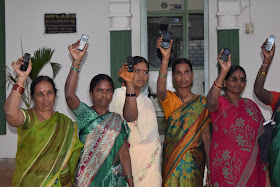At least 80% of my stories are on rural communities. I go to faraway hills, nomad hamlets and fishing villages and, I am always searching for signs where women in these most unheard communities are using technology for a better life. What I
find is always amazing: women, most of
them with little or no education, are using technology to fight for their
rights, health, freedom and an improved livelihood. Below are 10 photos of how
women in villages are using technology to adapt to climate change.
Tracking the weather
As the climate becomes more erratic every passing day, rural communities are finding it increasingly tough to rely on their traditional knowledge of weather. So, they are now learning to monitor it. In this photo, taken in Medak district of southern India, women of a village are using a mini weather station. Here, they track the movement of wind, cloud and measure temperature and rainfall - everything that will later help them plan their farming activities.
Using mobile phone technology
Mobile phones are immensely popular in India. But these women are using mobile phones in the smartest way possible: sharing information on weather, availability of seeds, fertilizer, soil testing facilities and so on.
They collaborate with the government and corporate houses to get this information. And once the information is received, they also follow up on the action ("did you hear, there will be a storm, so pick up your ripe vegetables now"). You can read more of these women and their amazing work in my story "Tech-savvy women farmers find success with SIM cards"
They collaborate with the government and corporate houses to get this information. And once the information is received, they also follow up on the action ("did you hear, there will be a storm, so pick up your ripe vegetables now"). You can read more of these women and their amazing work in my story "Tech-savvy women farmers find success with SIM cards"
Water budgeting
In the drought prone districts of India, ground water table is depleting rapidly. Finding out how much water your field has underneath the soil and choosing your crop accordingly is crucial to avoid a crop failure. And farmer Prabhavati Reddy is doing exactly that. She measures
the level of groundwater before every sowing season. Then, according to
the availability of water, she decides whether she should sow rice or a less water-dependent crop. You can read more of her story "And Not A Drop To Waste" that was also with winner of last year's All
India Environmental Journalism Award.
Conserving water
Judicious use of water is at the center of climate change adaptation. Framer Meenamma of Nellore district is therefore using irrigation technologies like sprinklers that will help her grow more with less water. She is also harvesting the rainwater to minimize her dependence on groundwater. Meenamma and her neighbors' story was a finalist and received a special mention at the 2015 SOPA award.
Restoring degraded land
Land degradation is one of the biggest threats to our future food security. In India, of the 417 million acres of land under cultivation, a whopping 296 million acres are degraded. Across India, thousands women are now engaged in restoration of degraded land. Here is what they do: identifying and uprooting invasive, useless and water absorbing plants, tilling the barren land, applying fresh silt and soft mud on it and increasing its moisture and nutrient content until its ready for cultivation. Also, they are digging percolation tanks that will help catch the rainwater and recharge the groundwater table.In short, they are blowing life into the 'dead' land. You can read more about them in this story.
Smart farming
In the deep of the forest, women of forest tribes are using sustainable farming methods such as multi-cropping that is helping them become food secure even as they face many challenges such as deforestation and displacement due to construction of mega dams. You can read more about them in my story "In the Shadow of Displacement, Forest Tribes Look to Sustainable Farming"
Using organic pesticide
Several landless thousands of women in southern India are joining hands to start organic farming. They use bio manure and instead of chemical pesticides, they use bio pesticide which are made of Neem and other tree extracts. they also use apply oil on the bottom of yellow bottles that attract and traps crop-eating bugs. This story - "Indian Farmers Flex Collective Muscles" will tell you more.
Recycling
In this factory located in Bundelkhand - a region in north central India, village women are earning a living by making recycled paper. In this photo, they are sitting on the paper pulp to squeeze the water out. I saw them singing, sharing a joke while doing this...life should be like that!
Using renewable energy
These women make a living by collecting and selling herbs and fruits from the forests. As more and more storms and cyclone began to heat India's coastline which is not very far from their home, the women struggled to keep their herbs dry. Now they are using solar energy-run dryers where they dry they produce very quickly and sell it quickly too. Here is my story on them : "Sun Shines On Forest Women".
Communicating climate change











No comments:
Post a Comment